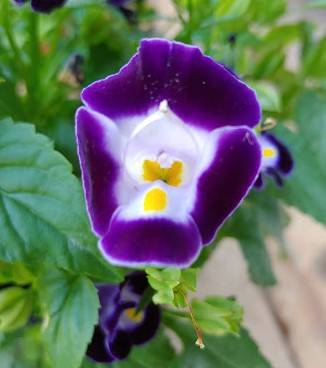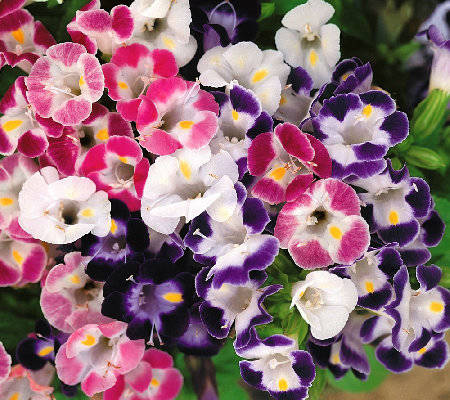As a gardening writer and teacher, I often visit nurseries seeking information or doing research while looking for needed items on a short list. Though I am an ardent plant lover, I go armed with the determination to avoid buying new plants. I am not prepared to fall head over heels in love at a nursery. On a recent visit, however, a gorgeous specimen caught my eye, breaking my resolve to stick to my list. A beautiful deep blue torenia joined my other purchases and came home with me.
Meeting a new plant is always exciting. Getting to know torenia and her numerous characteristics made it clear that she was an excellent plant to recommend to gardeners in West Hawaii.
First of all, Torenia fournieri is beautiful. Though yellow, pink and light blue varieties exist, the deep blue is perhaps the most striking. Torenias are members of the very large Scrophulariaceae or Snapdragon family that includes nearly 4,500 species. Several other members of the family are often grown here as well as the actual snapdragon. The indigenous bacopa is among her relatives as well as firecracker and Texas ranger plants.
Torenia fournieri is native to Thailand, Cambodia, Laos and Vietnam while several other torenias (T. sciatica and T.glabra) are native to other parts of tropical Asia. Torenia fournieri is credited with having the most attractive flowers, which has made her sought after as a lei plant as well as an addition to a garden.
Several common names have been attached to torenias including ola’a beauty and the wishbone flower. Both have obvious origin. The beauty of the flower earned its Hawaiian name while the small wishbone that her stamens create within the flower is the source of her other name.
Many different varieties of torenia exist. Each has somewhat unique qualities. Though most torenias have a compact growth habit several trailing varieties have been developed as spreading ground covers.
The “Summer Wave” hybrid has been cultivated to spread and to tolerate hot summer heat. It is an ideal choice for window boxes or hanging baskets. The “Duchess” strain is more compact and includes several shades of blue as well as a compact pink variety. Bouquet varieties come in a range of blues. The “Kauai deep blue” has the classic dark blue petals with a contrasting white throat and yellow tongue. Gorgeous!
The flowers are usually about an inch long, appearing singly on branches off erect stems. They are tubular with a larger upper lip and smaller lower lip. The throat is usually open and of a lighter color with the characteristic yellow tongue. Though the flowers are the most appealing feature of the torenias, the inch-long ovate leaves with serrated edges add to the plant’s attractiveness.
Appearance isn’t everything, however. Torenias have many additional features to recommend them. They are fast-growing, and the seedlings will produce flowers in the first few months. They hold flowers for a long time and with light pruning or tip pinching will continue to stay compact and flower profusely. They usually grow to about 12 inches tall and the standard will likely spread less than a foot from the center in each direction.
Torenias do best in slightly moist soil and in light shade at upper elevations. They prefer a humid environment but can grow well in hotter, dryer areas closer to the coast, when planted in deep shade with regular watering. Massed on a shady slope in moist soil that drains well, they make a spectacular display.
Propagating torenias from seed is relatively easy. Seeds form in the pods that appear behind spent flowers. If left in place, the seeds may drop and germinate near the base of the plant. Despite its ability to reseed itself, it is not considered an invasive species.
Seeds collected from the pods will usually germinate two or three weeks after being pressed into a sterilized commercial seeding mix. Do not cover the seeds because they need light to germinate. A constant temperature of about 70 degrees will encourage germination. Once the seedlings are healthy and actively growing they can be transplanted into larger pots or the garden. If placed about 6 inches apart they will quickly form an attractive mat of blossoms.
Torenia cuttings are also easy to grow. Cut a stem 4 to 6 inches long and place it in a pot with a 50:50 mix of vermiculite and perlite. The mix should stay moist but drain well. Within a month the cutting should put out new leaves and be ready to up pot in soil and fertilize lightly to gain strength before planting out. Cuttings as well as the new plants will do best in partial shade.
Place your torenias in a somewhat cool area where you can maintain moist (not wet) soil and they will thrive with little maintenance. Occasional light pruning will keep the plants compact and blooming. If grown in soil rich in organic matter they will need very little fertilizer. Organic or slow release products can be added a few times a year to augment their vitality.
Though torenias occasionally attract whiteflies and can develop powdery mildew, both of these issues can be controlled with a soap and neem oil spray if caught early. Mix the oil with water according to the directions and spray late in the day to avoid sun burning. Adding a small amount of liquid soap (ex: Dr. Bronners peppermint) will help keep the oil in suspension and provide sticking power to the mix.
Most nurseries carry some torenia varieties. Check local garden shops or order seeds online to add this lovely species to your garden or patio. It will surely delight you as much as it has enchanted me.
Diana Duff is a plant adviser, educator and consultant living part time in Kona.
Gardening Events
Saturday: “Work Day at Amy Greenwell Garden” from 9 a.m. to 12:30 p.m. Meet at the Garden Visitor Center across from the Manago Hotel in Captain Cook. Volunteers will be able to help with garden maintenance and are invited to bring a brown bag lunch. Water and snacks provided. Call Peter at 323-3318 for more information.
Farmer Direct Markets – check websites for new hours and online markets
Wednesday: “Ho’oulu Farmers Market” at Sheraton Kona Resort & Spa at Keauhou Bay
Saturday: “Keauhou Farmers Market” 8 a.m. to noon at Keauhou Shopping Center
“Kamuela Farmer’s Market” 7:30 a.m. to noon at Pukalani Stables
“Waimea Town Market” 7:30 a.m. to noon at the Parker School in central Waimea
“Waimea Homestead Farmers Market” from 7:30 a.m. to noon at the Waimea middle and elementary school playground
Sunday: “Pure Kona Green Market” 9 a.m. to 2 p.m. at Amy Greenwell Garden in Captain Cook
“Hamakua Harvest” 9 a.m. to 2 p.m. at Highway 19 and Mamane Street in Honokaa




